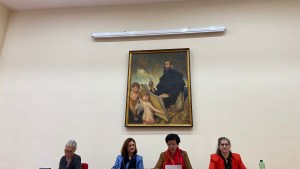“The way to the betterment of societies is through the education of girls and young women,” Pope Francis told participants at a conference on holy women taking place in Rome, on March 7, 2024, the day before International Women’s Day. As the Pope condemned discrimination against women in education that still occurs today, the conference highlighted two saints, Elizabeth Ann Seton and Mary Mackillop, who made it their mission to educate all, even when conditions were difficult.
“In a world where women still suffer so greatly from violence, inequality, injustice and mistreatment – something scandalous […] – one serious form of discrimination has to do precisely with the education of women,” the Pope’s speech said, which was read out by a prelate as the Pontiff is still sick. Educating girls and women “benefits overall human development,” he wrote, before taking the time to greet the participants individually.
The audience members were all taking part in a conference titled “Women in the Church: Builders of Humanity,” occurring on March 7 and 8 at the University of the Holy Cross in Rome.
The event focused on the stories of 10 holy women and what they have to teach both men and women today. For the panel on “charity in education,” the speakers focused on St. Elizabeth Ann Seton and St. Mary Mackillop, whose stories, despite both being marked by adversity and difficulty, showed their dedication to providing education for all.
The first free Catholic school in the US
St. Elizabeth Ann Seton was the first native-born American saint and lived from 1774 to 1821. She is credited with laying the foundations of Catholic education in the US. After losing her husband to tuberculosis, and being shunned by her community for converting from Episcopalianism to Catholicism, she moved to Baltimore, Maryland, where, supported by the local bishop, she began teaching young girls, straight out of her home.
“I think the charity of education sums up St. Elizabeth’s mission for education and for her school,” said Professor Susan Timoney of the Catholic University of America during the conference. We see St. Elizabeth’s “charity expressed in the desire to educate all children at a time when education was reserved primarily for the wealthy.”
She not only welcomed students of all economic backgrounds but also of other Christian religions, despite having been discriminated against herself. Still today around 19% of students in Catholic schools in the US are of another denomination or of none at all.
“I shunned any form of prejudice or discrimination. Inclusiveness was my goal, as Christian compassion is expressed universally rather than selectively,” St. Elizabeth wrote.
Educating all corners of Australia
Similarly St. Mary Mackillop “incarnated what a preferential option for the poor might look like,” said Professor Maeve Louise Heaney of the Australian Catholic University in Brisbane, Australia, during the conference.
Born in 1842, St. Mary Mackillop founded with the help of a local priest a religious congregation , the Sisters of Saint Joseph of the Sacred Heart, that would run local schools and children’s homes in Australia to help especially those who were disadvantaged and in rural areas.
She was known for saying “never see a need without doing something about it” and in fact in setting up these establishments was directly responding to the socioeconomic conditions in Australia then.
“Her work at that time was prophetic, education, Catholic education for those who otherwise would not have it,” said Professor Heaney, highlighting how the saint was able to read “the signs of the time.”
By the time of Mary Mackillop’s death in 1909 there were 600 Josephite sisters caring for 1,000 needy children and adults and teaching more than 12,400 students in 117 schools.
More than just teaching
Many of the participants at the conference in Rome were educators themselves, as the event was organized by a network of Catholic universities and other entities from across the world. Nuns, professors, priests, and more listened carefully to Professor Timoney and Professor Heaney’s presentation of these two female saints and their lives.
Some took notes, others concentrated on the voices coming through their headsets that were translating the conference. Both professors recalled the Pope’s speech from that morning, which was probably still resounding in many of the participants’s heads.
“I express my hope that your educational settings, in addition to being places of study, research and learning, places of ‘information,’ will also be places of ‘formation,’ where minds and hearts are opened to the promptings of the Holy Spirit,” the Pontiff had said.
“Ours is a time seared by hatred, in which our human family, which needs to feel the power of love, is instead frequently scarred by violence, war, and ideologies that stifle the noblest feelings of the human heart. Precisely in this context, the contribution of women is more necessary than ever.”


